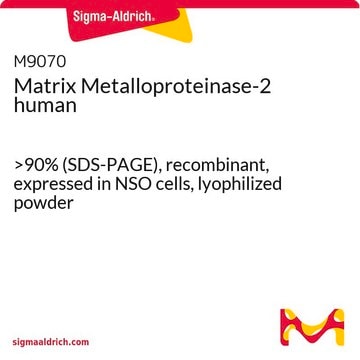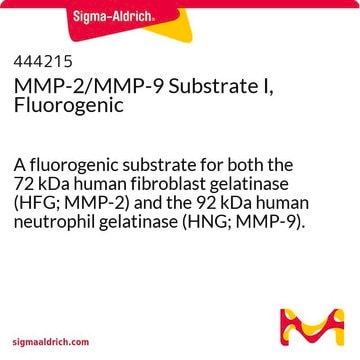おすすめの製品
詳細
Matrix Metalloproteinase-2 (MMP-2) is a member of the matrix metalloproteinase (MMP) family of proteins. MMPs participate in the breakdown of extracellular matrix in normal physiological processes like embryonic development, reproduction, and tissue remodeling, as well as in disease processes such as arthritis and metastasis. MMP-2 cleaves many substrates, including extracellular matrix components (collagens, fibronectin, and elastin), soluble metabolic mediators (e.g., apolipoproteins), secreted and extracellular matrix-anchored growth factors, and cytokines.
Along with MMP-9, MMP-2 is involved many pathophysiological processes, including leukocyte migration from the circulation into the tissue during inflammation, Chagas′ Cardiomyopathy, heart failure and chronic kidney disease. MMP-2 thus may be regarded as a potential therapeutic target.
As with most MMPs, MMP-2 is secreted as an inactive pro-protein, which becomes activated when cleaved by extracellular proteinases. This product is not pre-activated, and may be activated by APMA or otherwise
This product is expressed in human HEK 293 cells as a glycoprotein with a calculated molecular mass of 72 kDa (amino acids 110-660). The DTT-reduced protein migrates as a 75-80 kDa polypeptide on SDS-PAGE because of glycosylation. This protein is produced in human cells, without the use of serum. The human cells expression system allows human like glycosylation and folding, and often supports higher specific activity of the protein. This recombinant protein is expressed without artificial tags.
Along with MMP-9, MMP-2 is involved many pathophysiological processes, including leukocyte migration from the circulation into the tissue during inflammation, Chagas′ Cardiomyopathy, heart failure and chronic kidney disease. MMP-2 thus may be regarded as a potential therapeutic target.
As with most MMPs, MMP-2 is secreted as an inactive pro-protein, which becomes activated when cleaved by extracellular proteinases. This product is not pre-activated, and may be activated by APMA or otherwise
This product is expressed in human HEK 293 cells as a glycoprotein with a calculated molecular mass of 72 kDa (amino acids 110-660). The DTT-reduced protein migrates as a 75-80 kDa polypeptide on SDS-PAGE because of glycosylation. This protein is produced in human cells, without the use of serum. The human cells expression system allows human like glycosylation and folding, and often supports higher specific activity of the protein. This recombinant protein is expressed without artificial tags.
特徴および利点
- Highly purified protein without artificial fusion tags
- Expressed in human cells (HEK 293) for proper glycosylation
- High substrate activity after activation with APMA or other methods
物理的形状
This product is supplied as a 0.22 μm-filtered solution, containing 20 mM Trizma®, pH 7.5, containing 8 mM CaCl2, 119 mM NaCl, 20% Glycerol, and 0.05% Brij® 35.
保管および安定性
Store the product at –70 °C. The product retains its activity for at least 2 years as supplied. After initial thawing, it is recommended to store the protein in working aliquots at –70 °C.
法的情報
Brij is a registered trademark of Croda International PLC
Trizma is a registered trademark of Merck KGaA, Darmstadt, Germany
免責事項
This product is for R&D use only. Not for drug, household, or other uses. Please consult the Safety Data Sheet for information regarding hazards and safe handling practices
保管分類コード
12 - Non Combustible Liquids
WGK
WGK 1
引火点(°F)
Not applicable
引火点(℃)
Not applicable
適用法令
試験研究用途を考慮した関連法令を主に挙げております。化学物質以外については、一部の情報のみ提供しています。 製品を安全かつ合法的に使用することは、使用者の義務です。最新情報により修正される場合があります。WEBの反映には時間を要することがあるため、適宜SDSをご参照ください。
Jan Code
SAE0174-50UG-PW:
SAE0174-50UG:
SAE0174-VAR:
SAE0174-BULK:
試験成績書(COA)
製品のロット番号・バッチ番号を入力して、試験成績書(COA) を検索できます。ロット番号・バッチ番号は、製品ラベルに「Lot」または「Batch」に続いて記載されています。
M-J Hannocks et al.
Matrix biology : journal of the International Society for Matrix Biology, 75-76, 102-113 (2017-11-22)
This review focuses on the complementary roles of MMP-2 and MMP-9 in leukocyte migration into the brain in neuroinflammation, studied mainly in a murine model of experimental autoimmune encephalomyelitis (EAE) that has similarity to the human disease multiple sclerosis. We
Andrea Page-McCaw et al.
Nature reviews. Molecular cell biology, 8(3), 221-233 (2007-02-24)
Matrix metalloproteinases (MMPs) were discovered because of their role in amphibian metamorphosis, yet they have attracted more attention because of their roles in disease. Despite intensive scrutiny in vitro, in cell culture and in animal models, the normal physiological roles
Rugmani Padmanabhan Iyer et al.
American journal of physiology. Heart and circulatory physiology, 311(1), H190-H198 (2016-05-22)
Following myocardial infarction (MI), the left ventricle (LV) undergoes a series of cardiac wound healing responses that involve both the stimulation of robust inflammation to clear necrotic myocytes and tissue debris and the induction of extracellular matrix (ECM) protein synthesis
Zhengyuan Cheng et al.
International journal of molecular sciences, 18(4) (2017-04-12)
Gelatinases are members of the matrix metalloproteinase (MMPs) family; they play an important role in the degradation of the extracellular matrix (ECM). This effect is also crucial in the development and progression of chronic kidney disease (CKD). Its expression, as
Nayara I Medeiros et al.
Frontiers in immunology, 10, 800-800 (2019-05-07)
Background: Chagas cardiomyopathy is the main fibrosing myocarditis among known heart diseases. Development of cardiomyopathy has been related to extracellular matrix (ECM) remodeling, which are controlled by matrix metalloproteinases (MMPs) and cytokines, especially interleukin (IL)-1β. The convertion of 31KDa inactive
ライフサイエンス、有機合成、材料科学、クロマトグラフィー、分析など、あらゆる分野の研究に経験のあるメンバーがおります。.
製品に関するお問い合わせはこちら(テクニカルサービス)







